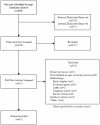Williams Syndrome and Music: A Systematic Integrative Review
- PMID: 30487769
- PMCID: PMC6246687
- DOI: 10.3389/fpsyg.2018.02203
Williams Syndrome and Music: A Systematic Integrative Review
Abstract
Background: Researchers and clinicians have often cited a strong relationship between individuals with Williams syndrome (WS) and music. This review systematically identified, analyzed, and synthesized research findings related to WS and music. Methods: Thirty-one articles were identified that examined this relationship and were divided into seven areas. This process covered a diverse array of methodologies, with aims to: (1) report current findings; (2) assess methodological quality; and (3) discuss the potential implications and considerations for the clinical use of music with this population. Results: Results indicate that individuals with WS demonstrate a high degree of variability in skill and engagement in music, presenting with musical skills that are more in line with their cognitive abilities than chronological age (CA). Musical strengths for this population appear to be based more in musicality and expressivity than formal musical skills, which are expressed through a heightened interest in music, a greater propensity toward musical activities, and a heightened emotional responsiveness to music. Individuals with WS seem to conserve the overall structure of musical phrases better than they can discriminate or reproduce them exactly. The affinity for music often found in this population may be rooted in atypical auditory processing, autonomic irregularities, and differential neurobiology. Conclusions: More studies are needed to explore how this affinity for music can be harnessed in clinical and educational interventions.
Keywords: Williams syndrome; affect; anxiety; auditory processing; cognition; imaging; musicality; review.
Similar articles
-
(A)musicality in Williams syndrome: examining relationships among auditory perception, musical skill, and emotional responsiveness to music.Front Psychol. 2013 Aug 16;4:525. doi: 10.3389/fpsyg.2013.00525. eCollection 2013. Front Psychol. 2013. PMID: 23966965 Free PMC article.
-
Musicality Correlates With Sociability and Emotionality in Williams Syndrome.J Ment Health Res Intellect Disabil. 2013;6(4):268-279. doi: 10.1080/19315864.2012.683932. J Ment Health Res Intellect Disabil. 2013. PMID: 24151530 Free PMC article.
-
Music Affinity and Emotion in Williams Syndrome.Music Med. 2020 Apr 24;12(2):122-129. doi: 10.47513/mmd.v12i2.686. Music Med. 2020. PMID: 39563885 Free PMC article.
-
Musical behavior in a neurogenetic developmental disorder: evidence from Williams Syndrome.Ann N Y Acad Sci. 2005 Dec;1060:325-34. doi: 10.1196/annals.1360.027. Ann N Y Acad Sci. 2005. PMID: 16597782 Review.
-
Musical ability.Ciba Found Symp. 1993;178:106-13; discussion 114-8. Ciba Found Symp. 1993. PMID: 8168360 Review.
Cited by
-
Innate frequency-discrimination hyperacuity in Williams-Beuren syndrome mice.Cell. 2022 Oct 13;185(21):3877-3895.e21. doi: 10.1016/j.cell.2022.08.022. Epub 2022 Sep 23. Cell. 2022. PMID: 36152627 Free PMC article.
-
Did Dog Domestication Contribute to Language Evolution?Front Psychol. 2021 Sep 13;12:695116. doi: 10.3389/fpsyg.2021.695116. eCollection 2021. Front Psychol. 2021. PMID: 34589022 Free PMC article.
-
Music and Language in Williams Syndrome: An Integrative and Systematic Mini-Review.Behav Sci (Basel). 2025 Apr 29;15(5):595. doi: 10.3390/bs15050595. Behav Sci (Basel). 2025. PMID: 40426373 Free PMC article. Review.
-
The Musical Abilities, Pleiotropy, Language, and Environment (MAPLE) Framework for Understanding Musicality-Language Links Across the Lifespan.Neurobiol Lang (Camb). 2022 Dec 16;3(4):615-664. doi: 10.1162/nol_a_00079. eCollection 2022. Neurobiol Lang (Camb). 2022. PMID: 36742012 Free PMC article. Review.
-
Autism and Williams syndrome: truly mirror conditions in the socio-cognitive domain?Int J Dev Disabil. 2020 Sep 10;68(4):399-415. doi: 10.1080/20473869.2020.1817717. eCollection 2022. Int J Dev Disabil. 2020. PMID: 35937179 Free PMC article. Review.
References
-
- Achenbach T. M. (1991). Manual for the Child Behavior Checklist. Burlington, NJ: University of Vermont, Department of Psychiatry.
-
- American Academy of Pediatrics, Committee on Genetics (2001). Health care supervision for children with Williams syndrome (RE0034). Pediatrics 107, 1192–1204. Available online at: http://pediatrics.aappublications.org/content/107/5/1192.long - PubMed
-
- Beck R. J., Cesario T. C., Yousefi A., Enamoto H. (2000). Choral singing, performance perception, and immune system changes in salivary immunoglobulin A and cortisol. Music Percept. 18, 87–106. 10.2307/40285902 - DOI
-
- Bentley A. (1985). Measures of Musical Abilities. Windsor, ON: Nfer-Nelson Publishing Company.
LinkOut - more resources
Full Text Sources


